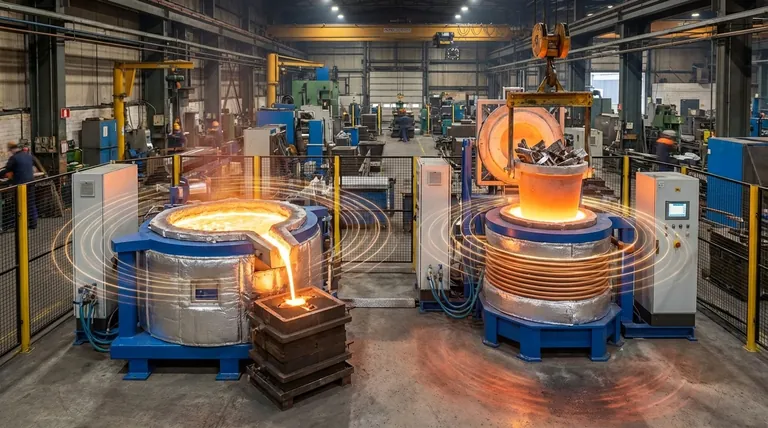The two primary types of induction heating are defined by the equipment used to apply the principle: the channel induction furnace and the coreless induction furnace. These designs serve distinct industrial purposes, with one excelling at holding and continuous melting of specific alloys, and the other providing versatility for a wider range of materials.
While both furnace types use the same physical principles to generate heat directly within a material, the choice between a channel and a coreless design is driven entirely by the specific application—primarily the metal's melting point and whether the operation is continuous or in batches.

The Fundamental Principle: How Induction Heating Works
To understand the difference between furnace types, we must first understand the core mechanism. Induction heating is a non-contact process based on two fundamental physical phenomena.
Electromagnetic Induction
An alternating electric current is passed through a coil, creating a fluctuating magnetic field around it. When a conductive material (like a metal) is placed within this field, the magnetic field induces electrical currents, known as eddy currents, inside the material itself.
The Joule Effect
These induced eddy currents flow against the material's electrical resistance. This resistance to the current flow generates intense and precise heat directly within the object, a phenomenon known as the Joule effect.
The Key Advantage: Internal Heat Generation
Unlike conventional furnaces that heat from the outside in, induction generates heat inside the object. This allows for extremely rapid heating and avoids contamination, as there is no direct contact with an external heating element.
Differentiating the Two Furnace Designs
The primary distinction between the two types of induction heating lies in the furnace's construction and how it applies the magnetic field, which in turn dictates its ideal use case.
The Channel (Core-Type) Furnace
This design is often used for melting metals with lower melting points. It is also exceptionally well-suited as a holding and superheating unit for higher-temperature alloys like cast iron. It operates most efficiently when running continuously with a single type of alloy.
The Coreless Furnace
The coreless furnace is a more versatile design. It is used for a much broader range of applications, including the melting of various alloys and demanding processes like steelmaking. Its construction makes it suitable for batch operations where the furnace may be completely emptied between melts.
Understanding the Practical Trade-offs
The choice between a channel and a coreless furnace is a strategic decision based on operational needs and metallurgical goals. There is no single "best" type; there is only the right tool for the job.
Channel Furnace: Efficiency vs. Inflexibility
The channel furnace is highly energy-efficient for maintaining the temperature of a large, continuous bath of molten metal. However, it is less flexible for frequent alloy changes or for starting up from cold, as it typically requires a "heel" of molten metal to operate.
Coreless Furnace: Versatility vs. Operation
The coreless furnace provides maximum operational flexibility. It can be started from cold with a solid charge and can be used to melt a wide variety of different metals and alloys. This versatility makes it the standard choice for foundries and steel plants that require frequent changes in production.
Making the Right Choice for Your Application
Selecting the correct furnace is critical for achieving both operational efficiency and the desired metallurgical quality. Your decision should be guided by your primary industrial goal.
- If your primary focus is holding large volumes of molten metal or continuously melting low-temperature alloys: The channel furnace is the more specialized and energy-efficient choice for this task.
- If your primary focus is melting a wide variety of alloys, including high-temperature metals like steel, in distinct batches: The coreless furnace provides the essential operational flexibility you need.
Understanding these two foundational furnace designs empowers you to select the precise tool for your specific industrial heating challenge.
Summary Table:
| Feature | Channel Furnace | Coreless Furnace |
|---|---|---|
| Primary Use | Holding & continuous melting | Batch melting & alloy changes |
| Best For | Low-melting-point alloys, cast iron | Steel, high-temperature alloys, variety of metals |
| Operation | Continuous (requires molten heel) | Batch (can start from cold) |
| Efficiency | High for maintaining large volumes | Versatile for frequent alloy changes |
| Flexibility | Lower (single alloy) | Higher (multiple alloys) |
Struggling to choose the right induction furnace for your lab or foundry? KINTEK specializes in lab equipment and consumables, providing expert guidance and high-performance induction heating solutions tailored to your specific metallurgical needs. Whether you require the continuous efficiency of a channel furnace or the versatile batch capabilities of a coreless system, our team ensures you get the precise tool for optimal results. Contact us today to discuss your application and discover how KINTEK can enhance your melting operations!
Visual Guide

Related Products
- Vacuum Heat Treat Sintering Brazing Furnace
- Vacuum Induction Melting Spinning System Arc Melting Furnace
- 1400℃ Laboratory Quartz Tube Furnace with Alumina Tube Tubular Furnace
- 600T Vacuum Induction Hot Press Furnace for Heat Treat and Sintering
- 1800℃ Muffle Oven Furnace for Laboratory
People Also Ask
- What is a vacuum furnace used for? Unlock Purity in High-Temperature Processing
- Can dissimilar metals be brazed or braze welded? A Guide to Strong, Reliable Joints
- What is the cost of a vacuum brazing furnace? A guide to key factors and investment strategy
- What are the different types of brazing welding? A Guide to Choosing the Right Heat Source
- What are vacuum furnaces used for? Unlock Ultimate Material Purity and Performance



















